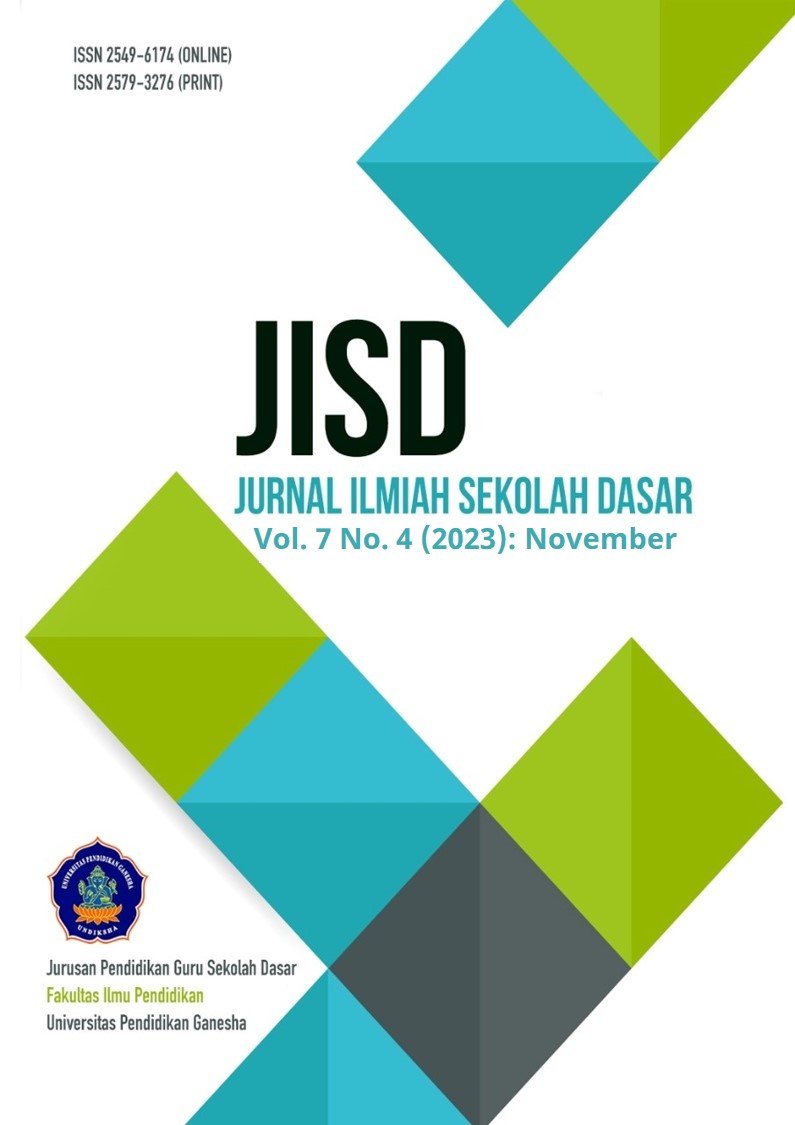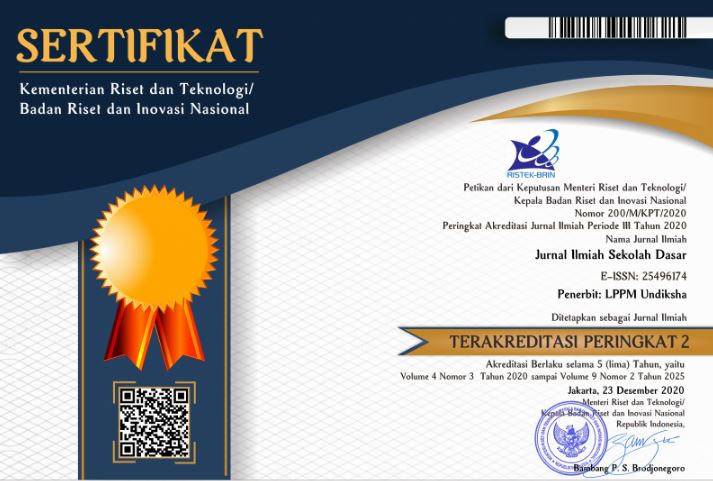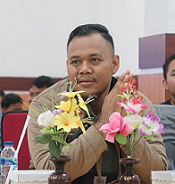Fifth Grade Elementary Science Psychomotor Assessment Instruments
DOI:
https://doi.org/10.23887/jisd.v7i4.59416Keywords:
Psychomotor, Elementary School, Assessment, Development, ScienceAbstract
The lack of variation in the assessment of the psychomotor domain in science learning in elementary schools and the need for appropriate assessment instruments in online practical learning. The study aimed to analyze the quality of the development of the psychomotor assessment instrument for fifth-grade elementary school children on limb material. This type of research is development research. The subjects of this study were 87 students in grade 5 elementary school. Retrieval of data with self-assessment sheets was carried out using the Google form. The questionnaire consists of 10 statement items with four answer choices. Sampling technique with purposive sampling. The criteria used in the decision were: 5th-grade elementary school students who had studied limb material. Content validity was verified using Aiken's V formula and construct validity using EFA. Calculation of instrument reliability using the Alpha Cronbach formula. The results of this study are that the psychomotor domain assessment instrument has valid and reliable instrument criteria. The instrument used has a validity value in the "Very valid" category and a reliability value in the "High" category. It can be concluded that the use of psychomotor assessment with nine development steps for elementary science learning can be used properly.
References
Adeoye, B. F. (2019). The Era of Digital Technology in Teaching and Learning in Nigeria Educational Institutions (pp. 43–51). https://doi.org/10.4018/978-1-5225-9746-9.ch004. DOI: https://doi.org/10.4018/978-1-5225-9746-9.ch004
Agustin Mulyani, S. (2014). Penggunaan Boneka Sebagai Media Simulasi Kreatif Di Sekolah Dasar. Jurnal Pemikiran Dan Pengembangan Sekolah Dasar, 1(2), 20. https://doi.org/10.22219/jp2sd.v1i2.1801. DOI: https://doi.org/10.22219/jp2sd.v1i2.1801
Al-Hunaiyyan, A., Alhajri, R., & Bimba, A. (2021). Towards an Efficient Integrated Distance and Blended Learning Model: How to Minimise the Impact of COVID-19 on Education. International Journal of Interactive Mobile Technologies, 15(10), 173–193. https://doi.org/10.3991/ijim.v15i10.21331. DOI: https://doi.org/10.3991/ijim.v15i10.21331
Al-Okaily, M., Alqudah, H., Matar, A., Lutfi, A., & Taamneh, A. (2020). Dataset on the Acceptance of e-learning System among Universities Students’ under the COVID-19 Pandemic Conditions. Data in Brief, 32. https://doi.org/10.1016/j.dib.2020.106176. DOI: https://doi.org/10.1016/j.dib.2020.106176
Alawiyah, F. (2017). Standar Nasional Pendidikan Dasar dan Menengah. Aspirasi, 8. https://doi.org/10.18844/wjet.v13i3.5952. DOI: https://doi.org/10.46807/aspirasi.v8i1.1256
Ambarwati, D., Herwin, H., & Dahalan, S. C. (2022). How elementary school teachers assess students’ psychomotor during distance learning? Jurnal Prima Edukasia, 10(1), 58–65. https://doi.org/10.21831/jpe.v10i1.45040. DOI: https://doi.org/10.21831/jpe.v10i1.45040
Bolton, D. L., & Lane, M. D. (2012). Individual entrepreneurial orientation: development of a measurement instrument. Education+ Training, 54(2), 219–233. https://doi.org/10.1108/00400911211210314. DOI: https://doi.org/10.1108/00400911211210314
Dettmer, P. (2005). New blooms in established fields: Four domains of learning and doing. Roeper Review, 28(2), 70–78. https://doi.org/10.1080/02783190609554341. DOI: https://doi.org/10.1080/02783190609554341
Edgar, S. N., & Elias, M. J. (2020). Setting the stage for Social Emotional Learning (SEL) policy and the arts. Arts Education Policy Review, 1–5. https://doi.org/10.1080/10632913.2020.1777494. DOI: https://doi.org/10.1080/10632913.2020.1777494
Gay, G. H. E. (2016). An assessment of online instructor e-learning readiness before, during, and after course delivery. Journal of Computing in Higher Education, 28(2), 199–220. https://doi.org/10.1007/s12528-016-9115-z. DOI: https://doi.org/10.1007/s12528-016-9115-z
Hekmah, N., Wilujeng, I., & Suryadarma, I. G. P. (2019). Web-Lembar Kerja Siswa IPA Terintegrasi Lingkungan untuk Meningkatkan Literasi Lingkungan Siswa. Jurnal Inovasi Pendidikan IPA, 5(2), 129–138. https://doi.org/10.21831/jipi.v5i2.25402. DOI: https://doi.org/10.21831/jipi.v5i2.25402
Herwin, H., Hastomo, A., Saptono, B., Ardiansyah, A. R., & Wibowo, S. E. (2021). How elementary school teachers organized online learning during the covid-19 pandemic? World Journal on Educational Technology: Current Issues, 13(3), 437–449. https://doi.org/10.18844/wjet.v13i3.5952. DOI: https://doi.org/10.18844/wjet.v13i3.5952
Hidayat, W. (2017). Adversity Quotient Dan Penalaran Kreatif Matematis Siswa Sma Dalam Pembelajaran Argument Driven Inquiry Pada Materi Turunan Fungsi. KALAMATIKA Jurnal Pendidikan Matematika, 2(1), 15. https://doi.org/10.22236/kalamatika.vol2no1.2017pp15-28. DOI: https://doi.org/10.22236/KALAMATIKA.vol2no1.2017pp15-28
Istiyono, E. (2020). Pengembangan Instrumen Penilaian dan Analisis Hasil Belajar Fisika Dengan Teori Tes Klasik dan Modern (Kedua. UNY Press.
Karakaita Putri, P. N. A., Arini, N. W., & Sumantri, M. (2019). Pengaruh Strategi Directed Reading Thinking Activity (DRTA) Berbantuan Media Flip Chart Terhadap Keterampilan Membaca Pemahaman. Jurnal Ilmiah Sekolah Dasar, 3(2), 158. https://doi.org/10.23887/jisd.v3i2.17762. DOI: https://doi.org/10.23887/jisd.v3i2.17762
Lai, A.-F., Chen, C.-H., & Lee, G.-Y. (2019). An augmented reality-based learning approach to enhancing students’ science reading performances from the perspective of the cognitive load theory. British Journal of Educational Technology, 50(1), 232–247. https://doi.org/10.1111/bjet.12716. DOI: https://doi.org/10.1111/bjet.12716
Mahendra, I. W. E. (2017). Project based learning bermuatan etnomatematika dalam pembelajar matematika. JPI (Jurnal Pendidikan Indonesia), 6(1), 106–114. https://doi.org/10.23887/jpi-undiksha.v6i1.9257. DOI: https://doi.org/10.23887/jpi-undiksha.v6i1.9257
Maison, M., Haryanto, H., Ernawati, M. D. W., Ningsih, Y., Jannah, N., Puspitasari, T. O., & Putra, D. S. (2020). Comparison of student attitudes towards natural sciences. International Journal of Evaluation and Research in Education, 9(1), 54–61. https://doi.org/10.11591/ijere.v9i1.20394. DOI: https://doi.org/10.11591/ijere.v9i1.20394
Maryati, M., Zubaidah, E., & Mustadi, A. (2019). A content analysis study of scientific approach and authentic assessment in the textbook of Curriculum 2013. Jurnal Prima Edukasia, 7(2), 128–138. https://doi.org/10.21831/jpe.v7i2.26792. DOI: https://doi.org/10.21831/jpe.v7i2.26792
Michalski, S. C., Szpak, A., Saredakis, D., Ross, T. J., Billinghurst, M., & Loetscher, T. (2019). Getting your game on: Using virtual reality to improve real table tennis skills. PLoS ONE, 14(9). https://doi.org/10.1371/journal.pone.0222351. DOI: https://doi.org/10.1371/journal.pone.0222351
Munandar, H., Junita, S., & dan. (2020). Pengembangan Instrumen Penilaian Psikomotorik Berbasis Peer Assessment Pada Kegiatan Praktikum IPA. Jurnal Tunas Bangsa, 7(2), 143. https://doi.org/10.46244/tunasbangsa.v7i2.1127. DOI: https://doi.org/10.46244/tunasbangsa.v7i2.1127
Nduru, M. P. (2022). Penilaian Aspek Kognitif, Afektif dan Psikomotorik di Masa Pandemi Covid 19 Kelas V Sekolah Dasar Inpres Onekore 6 Kecamatan Ende Tengah The Assessment of Cognitive, Affective and Psychomotor Aspects at Class V Inpres Onekore 6 Elementary School Ende Teng. http://journalfai.unisla.ac.id/index.php/at-thulab/index. DOI: https://doi.org/10.30736/atl.v6i2.1115
Nugraha, C. A., & Wahyono, S. B. (2019). Developing Interactive Multimedia Learning for Psychomotor Domain to Students of Vocational High School. Jurnal Kependidikan: Penelitian Inovasi Pembelajaran, 3(2), 220–235. https://doi.org/10.21831/jk.v3i2.21797. DOI: https://doi.org/10.21831/jk.v3i2.21797
Nur Jannah, I. (2020). Efektivitas Penggunaan Multimedia dalam Pembelajaran IPA di SD. Jurnal Ilmiah Sekolah Dasar, 4(1), 54. https://doi.org/10.23887/jisd.v4i1.24135. DOI: https://doi.org/10.23887/jisd.v4i1.24135
Pinilih, F., Budiharti, R., & Ekawati, E. (2013). Pengembangan Instrumen Penilaian Produk Pada Pembelajaran Ipa Untuk Siswa Smp. Jurnal Pendidikan Fisika Universitas Sebelas Maret, 1(2), 23–27. https://jurnal.fkip.uns.ac.id/index.php/pfisika/article/view/2798.
Pranata, Y. R. P. S. A. S. (2017). Pengembangan Media Boneka Tangan Berbasis Digital Storytelling. Kreatif Jurnal Kependidikan Dasar, 10, 627–636. http://journal.um.ac.id/index.php/jptpp/article/view/10332.
Pratiwi, I. A., Ardianti, S. D., & Kanzunnudin, M. (2018). Peningkatan kemampuan kerjasama melalui model project based learning (PjBL) berbantuan metode edutainment pada mata pelajaran ilmu pengetahuan sosial. Refleksi Edukatika: Jurnal Ilmiah Kependidikan, 8(2). https://doi.org/10.24176/re.v8i2.2357. DOI: https://doi.org/10.24176/re.v8i2.2357
Putri, F. S., & Istiyono, E. (2017). The Development of Performance Assessment of STEM-Based Critical Thinking Skill in the High School Physics Lessons. International Journal of Environmental & Science Education, 12(5), 1269–1281. https://eric.ed.gov/?id=EJ1278188.
Renganayagalu, S. kumar, Mallam, S. C., & Nazir, S. (2021). Effectiveness of VR Head Mounted Displays in Professional Training: A Systematic Review. Technology, Knowledge and Learning, 26(4), 999–1041. https://doi.org/10.1007/s10758-020-09489-9. DOI: https://doi.org/10.1007/s10758-020-09489-9
Riddell, J. (2015). Performance, Feedback, and Revision: Metacognitive Approaches to Undergraduate Essay Writing. Collected Essays on Learning and Teaching, 8, 79. https://doi.org/10.22329/celt.v8i0.4256. DOI: https://doi.org/10.22329/celt.v8i0.4256
Rosidin, U, Kadaritna, N., & Hasnunidah, N. (2019). Can argument-driven inquiry models have impact on critical thinking skills for students with differentpersonality types? Cakrawala Pendidikan, 38(3), 511–526. https://doi.org/10.21831/cp.v38i3.24725. DOI: https://doi.org/10.21831/cp.v38i3.24725
Rosidin, Undang, Herpratiwi, Suana, W., & Firdaos, R. (2019). Evaluation of National Examination (UN) and National-Based School Examination (USBN) in Indonesia. European Journal of Educational Research, 8(3), 827–837. https://doi.org/10.12973/eu-jer.8.3.827. DOI: https://doi.org/10.12973/eu-jer.8.3.827
Sintema, E. J. (2020). Effect of COVID-19 on the performance of grade 12 students: Implications for STEM education. Eurasia Journal of Mathematics, Science and Technology Education, 16(7), 1–6. https://doi.org/10.29333/EJMSTE/7893. DOI: https://doi.org/10.29333/ejmste/7893
Sukistono, D. (2008). Wayang Boneka untuk Anak. Pengkajian Penciptaan Wayang, 5(1). https://jurnal.isi-ska.ac.id/index.php/lakon/article/view/739/735.
Sulianto, J., Untari, M. F. A., & Yulianti, F. (2014). Profil Cerita Anak Dan Media Boneka Tangan Dalam Metode Bercerita Berkarakter Untuk Siswa Sd. Mimbar Sekolah Dasar, 1(2), 113–122. https://doi.org/10.17509/mimbar-sd.v1i2.872. DOI: https://doi.org/10.17509/mimbar-sd.v1i2.872
Wanabuliandari, S., & Ardianti, S. D. (2018). Pengaruh Modul E-Jas Edutainment terhadap Karakter Peduli Lingkungan dan Tanggung Jawab. Scholaria: Jurnal Pendidikan Dan Kebudayaan, 8(1), 70–79. https://doi.org/10.24246/j.js.2018.v8.i1.p70-79. DOI: https://doi.org/10.24246/j.js.2018.v8.i1.p70-79
Zeng, N. (2017). Effects of physical activity on motor skills and cognitive development in early childhood: A systematic review. In BioMed Research International (Vol. 2017). https://doi.org/10.1155/2017/2760716. DOI: https://doi.org/10.1155/2017/2760716
Downloads
Published
How to Cite
Issue
Section
License
Copyright (c) 2023 Benedicta Rani Nugraheni, Widihastuti, Edi Istiyono

This work is licensed under a Creative Commons Attribution-ShareAlike 4.0 International License.
Authors who publish with the Journal Ilmiah Sekolah Dasar agree to the following terms:
- Authors retain copyright and grant the journal the right of first publication with the work simultaneously licensed under a Creative Commons Attribution License (CC BY-SA 4.0) that allows others to share the work with an acknowledgment of the work's authorship and initial publication in this journal.
- Authors are able to enter into separate, additional contractual arrangements for the non-exclusive distribution of the journal's published version of the work (e.g., post it to an institutional repository or publish it in a book), with an acknowledgment of its initial publication in this journal.
- Authors are permitted and encouraged to post their work online (e.g., in institutional repositories or on their website) prior to and during the submission process, as it can lead to productive exchanges, as well as earlier and greater citation of published work. (See The Effect of Open Access)










